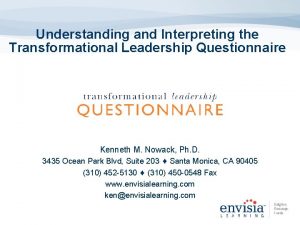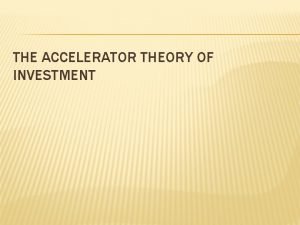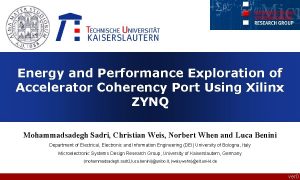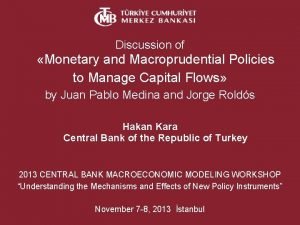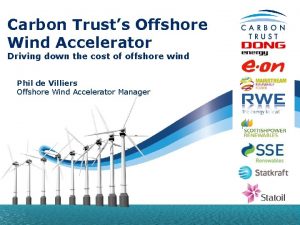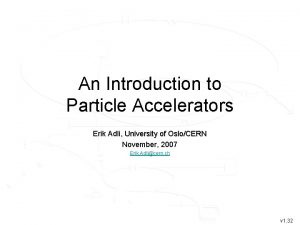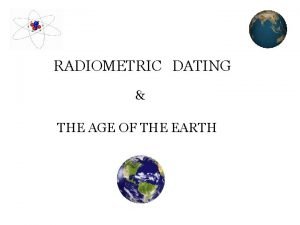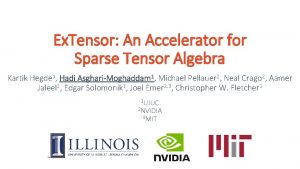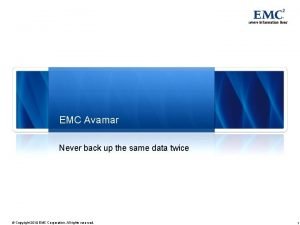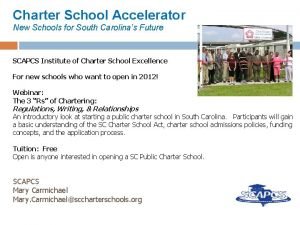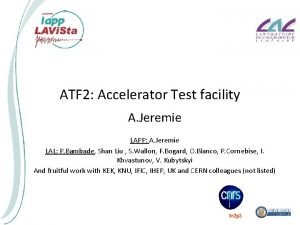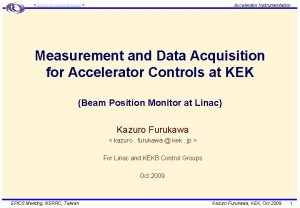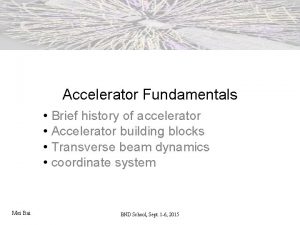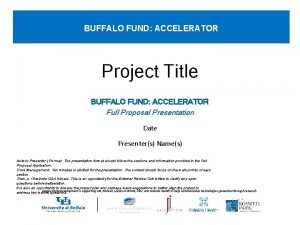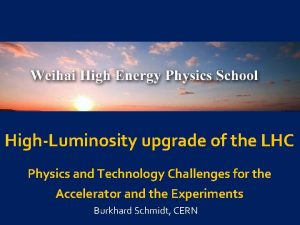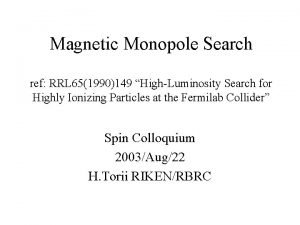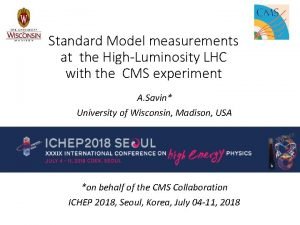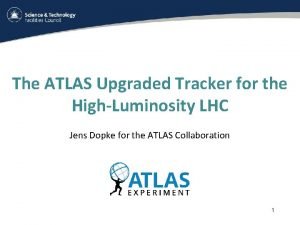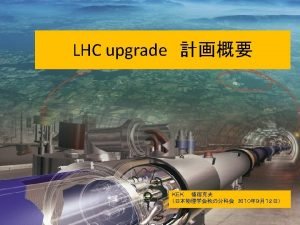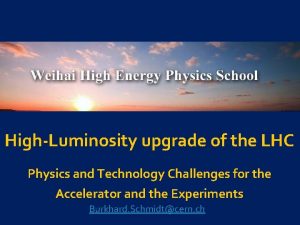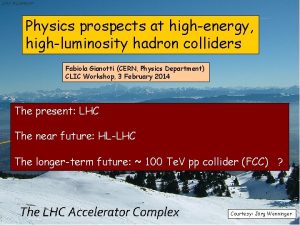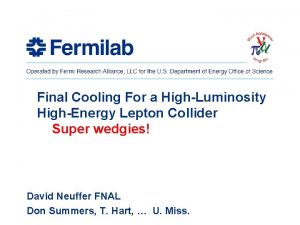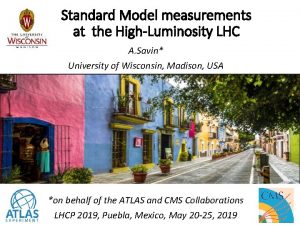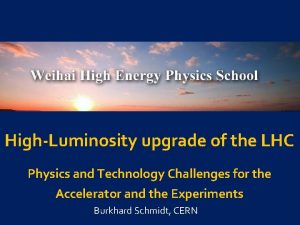HighLuminosity Accelerator Project MNPP01 a MNPP02 Activity of








![Strategy of Beta Squeezing in Phase-2 Phase LER HER βx* [mm] βy* [mm] scale Strategy of Beta Squeezing in Phase-2 Phase LER HER βx* [mm] βy* [mm] scale](https://slidetodoc.com/presentation_image_h/345b875c130f727fbdb3daae5f389b4c/image-9.jpg)








- Slides: 17

High-Luminosity Accelerator Project (MNPP-01) + a (MNPP-02) Activity of Multi-National Partnership Laboratory (MNPL) at KEK and its Approved Project (MNPP-01+a) “R&D for high luminosity colliders” Project (MNPP-01) Challenge to highest luminosity at Super. KEKB 2 x 1034 8 x 1035 Research Administration Department International Cooperation Office Multi-national Partnership Laboratory Coordinator 1 Junji Urakawa

Approved Project (MNPP-01) by KEK DG , which is described in the Annex-1 of bilateral Mo. U , Appendix under umbrella Mo. U or simple agreement. Title: R&D for high luminosity colliders (MNPP-01) “Project Manager”: Makoto Tobiyama Following 4 R&D tasks are set-up to realize the performance: 1. Development of IP feedback systems, 2. Development of advanced bunch feedback systems, 3. Minimization of gap transients, 4. Beam commissioning of the Super. KEKB accelerators. SLAC , CERN, LAL, Jefferson Lab, California Polytechnic State University By April 2021 Many bilateral Mo. Us were necessary to proceed this project, which took time after the approval. IHEP officially joined the MNPP-01 on 2017 September. Candidates for other Projects (MNPP-02, MNPP-03): MNPP-02 included three foreign institutes and one domestic University. The title of this project is “Novel superconducting magnet technologies towards the applications in future high-intensity accelerators”. It is under the process for the approval. MNPP-03 will include three foreign institutes and two domestic groups. Now MNPP-03 is under proposal preparation. 2

Concept of Multi-National Partnership Laboratory (MNPL) Institution-based Partnership of World Accelerator Laboratories Categories of KEK experiments Joint Usage Experiments For examples: Belle II, T 2 K 1) Invite application for experiments using KEK facilities. 2) Form collaboration. 3) Apply proposal. 4) Judge by Program Advisory Committee (PAC). 5) KEK user registration International Joint Research (New MNPP has to make many bilateral Mo. U with the explanation regarding the project) - KEK takes initiatives to form international joint research programs using KEK facilities or improving/creating facilities. - Based on agreements (Mo. U) between KEK and participating Institutes (bilateral Mo. U or Appendix or simple agreement) - Call it “MNP-Project” Purpose of MNPL: - Offers a framework to coordinate the MNP-Projects and to support the participating researchers from abroad. - Integrates the bilateral cooperation to form a unified framework for partnership. 3

Super. KEKB Luminosity Target History of Peak Luminosity (e+/e- colliders) 8 x 1035 Target integrated luminosity is 50 ab-1. (~10 year operation) 2. 1 x 1034 1970 1980 1990 2000 x 40 !! 2010 2020

Major upgrades towards KEKB× 40 Taking advantage of existing items ・ the KEKB tunnel, Belle detector is ・ the KEKB components upgraded to Belle II as much as possible! New QCS magnet for Nano-beam scheme New superconducting final focusing quads New beam pipe& bellows Ti. N-coated beam pipe with antechambers Main ring arc and straight section: Redesign the lattices of both rings to reduce the emittance KEKB Super KEKB Main ring arc section: LER: Replace all main dipoles HER: Preserve the present cells New design for IR Add / modify RF systems for higher beam current New low emittance e gun B 2 GM New and re-use wiggler magnets are mixed: Oho section (LER&HER) Nikko section (LER) Positron damping ring New e+ source 5

Super. KEKB commissioning phases Feb. 2016 ~ June 2016 Phase 1 w/o QCS and Belle II Mid Feb. 2018 ~ July 2018 ~ autumn 2018 Phase 2 w/QCS and Belle II Phase 3 Physics Run BKG study Luminosity tuning Target luminosity: 1 x 1034 cm-2 s-1 Luminosity tuning w/o Vertex detector vacuum scrubbing basic machine tuning No beam collision Already done! Damping ring commissioning: from Dec. 4 th 2017


Tasks in Phase 2 • Basic tuning • Beam injection of the beam from DR, vacuum scrubbing… • Performance check of QCS magnets • Squeezing IP beta functions at IP • Optics corrections • • • Beam collision tuning with “Nano beam scheme” Belle II beam BG study and tuning Other studies: electron clouds, other instabilities… Luminosity tuning Physics Run
![Strategy of Beta Squeezing in Phase2 Phase LER HER βx mm βy mm scale Strategy of Beta Squeezing in Phase-2 Phase LER HER βx* [mm] βy* [mm] scale](https://slidetodoc.com/presentation_image_h/345b875c130f727fbdb3daae5f389b4c/image-9.jpg)
Strategy of Beta Squeezing in Phase-2 Phase LER HER βx* [mm] βy* [mm] scale 2. 0* 384 81 12 x 300 400 81 16 x 270 2. 1 384 5. 4 12 x 20 400 6 16 x 20 2. 2 256 2. 16 8 x 8 200 2. 4 8 x 8 2. 3 128 2. 16 4 x 8 100 2. 4 4 x 8 2. 4 128 1. 08 4 x 4 100 1. 2 4 x 4 3. x 32 0. 27 1 x 1 25 0. 30 1 x 1 adiabatic squeezing We hope to squeeze the IP beta functions down to 4 x 8 in Phase 2. If possible, 4 x 4 is desirable. 9

Issues • IR design and dynamic aperture • Optics corrections & Low emittance tuning • Beam-beam related issues • IP orbit control to maintain beam collision • Beam loss and beam injection • Electron clouds • Injector upgrade for low emittance & high intensity beams • Detector beam background The items in red were partially studied in Phase 1.

Comparison of parameters in 3 phases Phase 1 Phase 2 Phase 3 IR No Belle II, No QCS w/ QCS Belle II w/o vertex w/ QCS Belle II w/ vertex Damping ring No damping ring w/ damping ring Beam current (L/H) 1. 01 A/0. 87 A 1~1. 8 A/0. 8~1. 3 A 3. 6 A/2. 6 A by* (L/H) No QCS 2. 2 mm/2. 4 mm 0. 27 mm/0. 30 mm ex (L/H) 1. 8 nm/4. 6 nm*) 1. 9 nm/4. 4 nm*) ey (L/H) 8 pm/6~45 pm*) 38 pm/88 pm**) 8. 6 pm/11. 5 pm**) xy(L/H) No beam collision 0. 024/0. 026 0. 088/0. 081 Luminosity No beam collision 1 x 1034 cm-2 s-1 8 x 1035 cm-2 s-1 *) w/o beam-beam interaction, w/o intra-beam scattering **) w/ beam-beam interaction, w/ intra-beam scattering A lot of difficult works should be done in Phase 2 and 3.

Super. KEKB Luminosity Projection

Novel superconducting magnet technologies towards the applications in future high-intensity accelerators Toru Ogitsu KEK, Cryogenics Science Center Candidates for other Projects (MNPP-02): MNPP-02 included three foreign institutes and one domestic University. The title of this project is “Novel superconducting magnet technologies towards the applications in future high-intensity accelerators”. It is under the process for the approval.

Recent Achievements in HTS Technologies • Transmission Line Technologies for Accelerator • HL-LHC Current Link • Transmission Line Magnets for FCC • HTS Magnets for High Radiation Environments • R&D study for secondary beam capture solenoid

Transmission Line and Related Technologies in Accelerator Transmission line magnet proposed at CERN

High Efficiency Superferric Magnet R&D Use transmission Line Technology • Mg. B 2 with 20 K • Forced Flow Helium Gas Cooling

• Amalia Ballarino • Develop Mg. B 2 transmission line system. • Study applicability of transmission line to superferric magnet. • Study applicability to future programs at CERN
 Transformational leadership questionnaire tlq
Transformational leadership questionnaire tlq Accelerator theory of investment
Accelerator theory of investment Swift biz
Swift biz Netbackup accelerator forced rescan
Netbackup accelerator forced rescan Ib economics fiscal policy
Ib economics fiscal policy Accelerator coherency port
Accelerator coherency port Financial accelerator
Financial accelerator Offshore wind accelerator
Offshore wind accelerator Proton
Proton Netbackup vmware backup process flow
Netbackup vmware backup process flow Dating
Dating Open capi
Open capi Extensor: an accelerator for sparse tensor algebra
Extensor: an accelerator for sparse tensor algebra Avamar overview
Avamar overview Charter network accelerator
Charter network accelerator Accelerator
Accelerator Accelerator
Accelerator Microsoft virtual machine converter solution accelerator
Microsoft virtual machine converter solution accelerator
